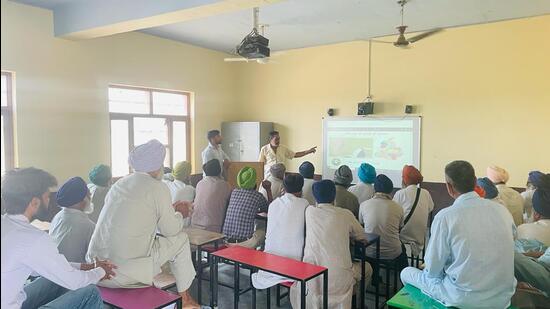Tubewells in vogue leave canal water underutilised in Punjab’s Barnala, Sangrur, Patiala
Despite presence of groundwater to be the deepest in Barnala, Sangrur and Patiala, the canal water is being underutilised for irrigation in these districts.
Despite presence of groundwater to be the deepest in Barnala, Sangrur and Patiala, the canal water is being underutilised for irrigation in these districts. The level of groundwater in Barnala district has fallen below 39 metres in Barnala and 37 metres in Sangrur, followed by 30.33 metres in Patiala. In other districts the table of water is above 30 metres.

The main canals and branches which supply water in these districts are Bhakra Main Line (BML) canal, Ghaggar branch and Patiala feeder. Only 21% water of Bhakra Main Line (BML) canal, 31% of Ghaggar branch and 45% Patiala feeder is being used for irrigation purpose, as per the water resources department.
The figures came to fore during a recent campaign of the water resources department for encouraging farmers to use canal water and stop excessive use of ground water for irrigation purpose. During the campaign, officials of the department are on a visit to villages, different blocks and schools to organise awareness events.
Based on the latest figures, the department has prepared a report to apprise the farmers about grave situation of ground water depletion of Punjab.
Tubewells doubled in three decades
The officials said that less use of canal water and excessive use of ground water through tubewells is the major reason of water depletion. As per the data of the department, the number of tubewells has almost doubled in the last three decades. The number of total tubewells in 1990-91 was 8 lakh which is now reached to 14.76 lakh. Lack of supply, damaged and broken traditional system is the reason behind underutilisation of canal water
Farmers and agricultural experts said that vanished or damaged old irrigation lines, absence of infrastructure and increase in tubewells are the major reason behind underutilisation of canal water. Besides, irrigation with canal water required special efforts, time, hardwork and sometime labour and extra expenses.
Chief agriculture officer Harbans Singh said, “The farmers are using canal where the underground pipes are laid. Concrete and temporary irrigation lines constructed for supplying water to fields from canal were damaged or wiped out with the passing of time. Besides, there is need for special efforts like keeping irrigation lines clean from grass and it also costs them as the farmers prefer to hire labourers for it.”
“The canal irrigation also requires farmers to remain present in the fields while on the other side, they just have to push the button to irrigate their fields with tubewells,” he added.
Bhupinder Singh, state committee member of Kisan Kirti Union, said, “Facility of tubewells, unawareness, about benefits of canal water, damaged concrete irrigation lines, delay in releasing water in canals are keeping farmers away from using canal water. Besides, the canal water does not reach all fields in the absence of infrastructure. Around 60 villages of Sangrur, Barnala and Malerkotla have always remained deprived of canal water as there is no arrangement of supplying it to them.”
Water resources minister, Gurmeet Singh Meet Hayer said ground water extraction rate in all blocks of Punjab is the highest in the entire country. “Taking this problem head on and in order to secure the future of the state chief minister Bhagwant Maan-led state government has undertaken a state-wide drive to restore water courses which had been abandoned or demolished in the past 20 to 30 years”, he said.
Hayer said teams of Water Resources Department officials from the rank of beldar to superintending engineers are visiting villages and informing people about the dire situation of ground water in the state and also telling them about the benefits of canal water. “We are also creating an infrastructure for canal water. People have also given a good response to this drive and are assisting the department in restoring water courses abandoned decades ago.” Hayer said.






